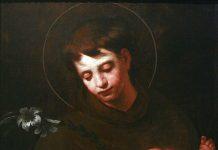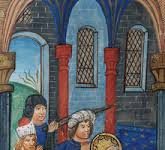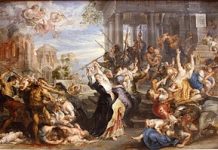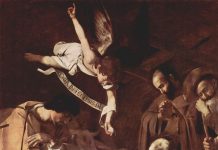Let the same mind be in you that was in Christ Jesus (Phil 6:14).
Two Sundays ago, when we celebrated the Feast of the Exaltation of the Holy Cross, you may remember that our second reading was essentially the same text we have just heard from St. Paul’s Epistle to the Philippians. We return to it for our consideration and prayer today so that we might further deepen our understanding of the mind and Heart of Christ; revealed as they are in this canticle that summarizes for us the Mystery of the Cross, the Mystery of Faith: “Christ Jesus … emptied himself. … He humbled himself and became obedient to the point of death—death on a cross” (Phil 2:6-11).
The hymn successfully evokes all the phases of our Lord’s existence, from His pre-existence as the eternal Word of God, to His Incarnation, Passion and, lastly, His glorification and exaltation as Lord. When we gaze upon the Crucified Lord we see before us the most concise and comprehensive statement about the Word made flesh. Jesus emptied himself. The term that is given to this self-emptying is kenosis, a Greek word that expresses the self-abasement of the eternal Word of God in the Redemptive Incarnation. In the kenosis, our Lord’s glory as the eternal Son of the Father is withheld, hidden. In the Holy Sacrifice of the Mass this kenosis is re-presented for us sacramentally, and both His divinity and humanity are both hidden; veiled in the sacramental signs of bread and wine. We who receive the Holy Eucharist are taken up in this oblation, this self-emptying; and this dynamic becomes the animating principle of our life in Christ. We too empty ourselves in imitation of our Saviour; and so we give ourselves in love in a variety of ways, mindful that self-giving, sacrificial love is the means to our fulfillment for we are created in the image and likeness of God whose Trinitarian life is self-surrender and love. In becoming Man and in dying for our salvation, Jesus our Lord reveals to us the true nature of God who wills to share His life with us. The Mass is the means by which this transformative union with God is most effectively brought about. Our self-offering in union with the offering of our Lord is the fullest expression of our participation in the Holy Sacrifice of the Mass.
In the Proverbs of Solomon is written: “If you sit down to eat at the table of a ruler, observe carefully what is set before you; then stretch out your hand, knowing that you must provide the same kind of meal yourself” (Prov 23:1). St. Augustine asks: “What is this ruler’s table if not the one at which we receive the Body and Blood of Him who laid down His life for us? What does it mean to sit at this table if not to approach it with humility? What does it mean to observe carefully what is set before you if not to meditate devoutly on so great a gift? What does it mean to stretch out one’s hand, knowing that one must provide the same kind of meal oneself, if not what I have just said: as Christ laid down his life for us, so we in our turn ought to lay down our lives for our brothers?” (from a treatise on John by St. Augustine; The Liturgy of the Hours, Vol. II, p.449-450). A life centred on the Eucharistic Sacrifice of Christ our Lord is a participation in this Mystery of God’s self-giving and self-emptying love. When we approach this Mystery with humility and devotion, with longing and generosity, our lives become Eucharistic and we reflect the goodness of God. Devotion to the Blessed Sacrament is essential to Christian life. The Saints whom we venerate and imitate were men and women who made this Eucharistic love of God real and tangible through their participation in our Lord’s kenotic Mystery.
This past week we celebrated the memorial (September 23) of St. Pio of Pietralcina or Padre Pio as he is more commonly known. Padre Pio bore the stigmata or wounds of Christ for over fifty years. These wounds never became infected but they bled. They conformed this priest to the Passion of our Lord in a manner that was altogether unique, mystical. Yet in every other way Padre Pio was conformed to the Mystery of our Lord’s Sacrifice as you and I are. In this sense, his life was very ordinary; so much so, that when he died in 1968, Pope Paul VI said of him: “Look at what fame he had, what a worldwide following gathered around him! But why? Perhaps because he was a philosopher? Because he was wise? Because he had resources at his disposal? It was because he said Mass humbly, heard confessions from dawn to dusk and was—it is not easy to say it—one who bore the wounds of our Lord. He was a man of prayer and of suffering.” This priest was at once both absolutely extraordinary and very ordinary in the fulfillment of his duties. Why was he raised up by God in our times? Was it perhaps because the years that have followed his death have been so confusing and difficult for the Church? Is it possible that our Lord gave him to us so that we might have a guide, a model of what it means to live the Mystery of Christ? The truth is that each and every one us is like Padre Pio both in his exceptionalism and his ordinariness. “Each one of us is the result of a thought of God. Each of us is willed, each of us is loved, each of us is necessary” (Pope benedict XVI). Herein lays our uniqueness. And each one of us is called to make our own the words of the Apostle as they specifically refer to us: “I have been crucified with Christ; it is no longer I who live, but Christ who lives in me; and the life I now live in the flesh I live by faith in the Son of God, who loved me and gave himself for me” (Gal 2:20). Padre Pio was given to us as prophet for an age that has become destructively addicted to pleasure and pain killers. The year of his death, 1968, is considered by many to have been a revolutionary year, a time of almost universal social upheaval. Indeed, in two generations our culture has modified itself in radically unexpected ways. Could it be that Padre Pio was a gift from God for our times and a witness to the enduring value and purpose of a life of sacrifice and devotion? The truth of Christ remains the same. “Jesus Christ is the same yesterday and today and forever” (Heb 13:8).
The Church has suffered much confusion in the years following Padre Pio’s death. In 1972, on the Feast of Sts. Peter and Paul, Pope Paul VI delivered a sermon that startled the world. Describing the chaos then consuming the Church, he said, “From some fissure the smoke of Satan has entered the temple of God.” A close collaborator of the pope, his Master of Ceremonies has said that the Holy Father spoke of the smoke of Satan because he maintained that those priests who turned Holy Mass into dry straw in the name of creativity, in reality were possessed of the vainglory and the pride of the Evil One. So, the smoke of Satan was nothing other than the mentality which wanted to distort the traditional and liturgical canons of the Eucharistic ceremony. Padre Pio however, said Mass humbly. This is why the faithful flocked to assist at his Masses. This is how we must also both celebrate and assist at Holy Mass; with humility, with love and devotion. The stigmata that he bore were an outward sign of the love with which our Lord has loved us. Padre Pio responded to Love Crucified with a crucified love, literally. His devotion and the love that he inspired enabled him to establish a hospital known as the House for the Relief of Suffering. This is the kenosis of Christ our Saviour at work in the life of His disciples; self-emptying that results in fruitful self-giving. Our self-emptying in our own, specific state in life is the means by which we unite our life to the redeeming Life of our Lord, and the means by which we are fulfilled. What we do here sacramentally enables and empowers us to relieve the sufferings of others. Let us foster in ourselves and in others a deep love of the Mass and the Most Blessed Sacrament for “the gift of love enables us to become in reality what we celebrate as mystery in the sacrifice” (Fulgentius of Ruspe, Liturgy of the Hours, Vol. IV, p. 379).











